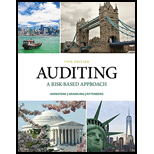
Diamond Foods, Inc.
(LO 8, 9)
In February 2012, the Wall Street Journal reported that Diamond Foods, Inc. fired its CEO and CFO, and would restate financial results for two years. The restatement was required after the company found that it had wrongly accounted for crop payments to walnut growers. The investigation focused primarily on whether payments to growers in September 2011 of approximately $60 million and payments to growers in August 2010 of approximately $20 million were accounted for in the correct periods. Shareholders suing the company allege the payments may have been used to shift costs from a prior fiscal year into a subsequent fiscal year. In a February 2012 filing with the SEC, the audit committee stated that Diamond had one or more material weak nesses in its internal control over financial reporting. In January 2014, the SEC charged Diamond Foods and two former executives for their roles in the accounting scheme to falsify walnut costs in order to boost earnings and meet estimates by stock analysts. Diamond Foods agreed to pay $5 million to settle the SEC’S charges.
a. Does the restatement suggest that the company’s internal controls contained a material weakness? Explain your rationale.
b. In September 2011, the company filed its annual report with the SEC for its fiscal year ended July 31, 2011. As part of that filing, the company maintained that it had effective internal controls over financial reporting as of its year-end date. Do you believe that management’s report on internal control over financial reporting was accurate?
c. In February 2012, the audit committee indicated that the company had ineffective internal controls. What types of material weaknesses do you think might exist at Diamond?
Trending nowThis is a popular solution!

Chapter 3 Solutions
Auditing: A Risk Based-Approach (MindTap Course List)
- Need help with this financial accounting questionarrow_forwardBayside Manufacturing's budgeted variable overheads for a period amounted to $30,000. During this period, the company spent $29,400 on variable overheads. The company's level of production was expected to require 15,000 labor hours, but the actual amount of labor hours used was only 13,500 hours. What was the variable overhead expenditure variance for the period?arrow_forwardWhat is the cash paid for rent during 2022 ?arrow_forward
- Financial Accountingarrow_forwardWhy does sustainability integration affect measurement choices? (1) Integration creates problems (2) Traditional measures capture everything (3) Environmental impacts require specialized valuation methods (4) Standard methods work fine Find outarrow_forward?!arrow_forward
- What is stellar enterprises current income tax expense or benefit on these financial accounting question?arrow_forwardA company has a total cost of $50.00 per unit at a volume of 100,000 units. The variable cost per unit is $20.00. What would the price be if the company expected a volume of 120,000 units and used a markup of 50%?Hii, Tutor Give answer to this Problemarrow_forwardCompute the company's degree of operating leverage?arrow_forward
- Why does sustainability integration affect measurement choices? (1) Integration creates problems (2) Traditional measures capture everything (3) Environmental impacts require specialized valuation methods (4) Standard methods work MCQarrow_forwardA company has a total cost of $50.00 per unit at a volume of 100,000 units. The variable cost per unit is $20.00. What would the price be if the company expected a volume of 120,000 units and used a markup of 50%?arrow_forwardWhy does sustainability integration affect measurement choices? (1) Integration creates problems (2) Traditional measures capture everything (3) Environmental impacts require specialized valuation methods (4) Standard methods work fine ??arrow_forward
 Auditing: A Risk Based-Approach (MindTap Course L...AccountingISBN:9781337619455Author:Karla M Johnstone, Audrey A. Gramling, Larry E. RittenbergPublisher:Cengage Learning
Auditing: A Risk Based-Approach (MindTap Course L...AccountingISBN:9781337619455Author:Karla M Johnstone, Audrey A. Gramling, Larry E. RittenbergPublisher:Cengage Learning Financial Reporting, Financial Statement Analysis...FinanceISBN:9781285190907Author:James M. Wahlen, Stephen P. Baginski, Mark BradshawPublisher:Cengage Learning
Financial Reporting, Financial Statement Analysis...FinanceISBN:9781285190907Author:James M. Wahlen, Stephen P. Baginski, Mark BradshawPublisher:Cengage Learning

